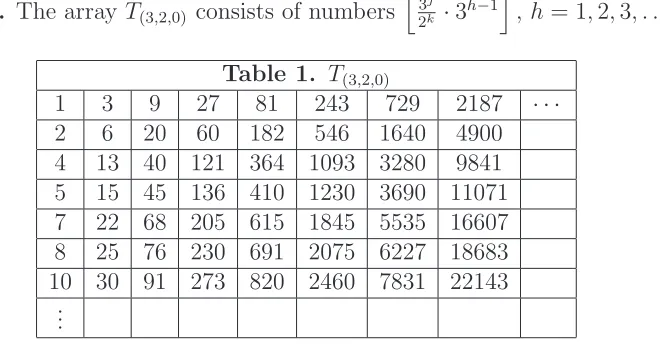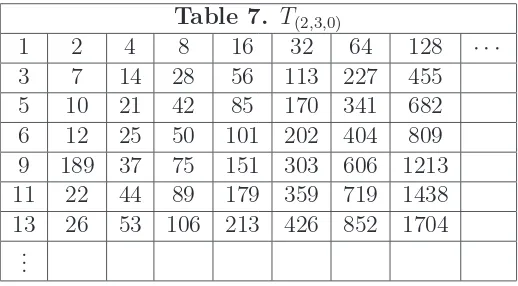23 11
Article 07.5.1
Journal of Integer Sequences, Vol. 10 (2007), 2
3 6 1 47
Interspersions and Fractal Sequences
Associated with Fractions
c
j
/d
k
Clark Kimberling
Department of Mathematics
University of Evansville
1800 Lincoln Avenue
Evansville, IN 47722
USA
[email protected]
Abstract
Supposec≥2 andd≥2 are integers, and letSbe the set of integers
cj/dk
, where
j andkrange over the nonnegative integers. Assume thatc anddare multiplicatively independent; that is, if p and q are integers for which cp = dq, then p = q = 0.
The numbers inS form interspersions in various ways. Related fractal sequences and permutations of the set of nonnegative integers are also discussed.
1
Introduction
Throughout this article, the lettersc, d, j, k, p, q, h, m, n represent nonnegative integers such that c≥2 and d≥2, and cand d are multiplicatively independent; that is, if cp =dq, then
p=q = 0.
Definitions, examples, and references for the termsinterspersion andfractal sequence are easily accessible ([9, 10, 11, 7]), so that only a brief summary is given in this introduction. This introduction also presents certain new arrays defined from the manner in which the fractions cj/dk are distributed. The main purpose of the article is to prove that each such
array is an interspersion.
Definition. An arrayA= (amh), m≥1, h≥1,of positive integers is aninterspersion if
(I3) every column of A is an increasing (possibly finite) sequence;
(I4) if (uh) and (vh) are distinct rows of A, and p and q are indices for whichup < vq <
up+1, then
up+1 < vq+1 < up+2.
Example 1 below illustrates the manner in which property (I4) matches the name “inter-spersion”; viz., the terms of each row individually separate and are separated by the terms of all other rows (after initial terms).
Definition of the array T(c,d,k0) = {t(m, h)}. Row 1 is defined by t(1, h) = c
. According to Lemma 2 below, every n
has infinitely many representations
cj/dk
, and we choose the one for which k is minimal (with k≥k0), noting that j is uniquely determined by k.The rest of row m is then defined
by
5 15 45 136 410 1230 3690 11071
7 22 68 205 615 1845 5535 16607
8 25 76 230 691 2075 6227 18683
10 30 91 273 820 2460 7831 22143 ...
Table 1 shows how an interspersion begets a fractal sequence: for each n, we write the number of the row containing n:
a sequence which contains itself as a proper subsequence (infinitely many times).
To conclude this introduction, we note that the arrays T(c,d,k0) represent a class of
in-terspersions new to the literature. A few historical notes will help to place the topics of interspersions, dispersions, and fractal sequences within a wider context. Possibly the ear-liest published array which is an interspersion was published by Kenneth Stolarsky [8] with a revealing title, “A set of generalized Fibonacci sequences such that each natural number belongs to exactly one”. In 1980, David Morrison introduced another interspersion, the Wythoff array. Both the Stolarksy and Wythoff arrays are presented in Neil Sloane’sClassic Sequences [7], which also gives additional twentieth century references, including [2], where the terms “interspersion” and “dispersion” are introduced and proved equivalent, and [3] in which fractal sequences are defined. Twenty-first century references include [1, 4].
2
Verification of interspersion properties
Lemma 1. Suppose s/r is a positive irrational number and 0 < δ < ǫ. Then there exist arbitrarily large integers j and k such that
δ < jr−ks < ǫ. (1)
Proof. First, supposeδ = 0.Letji/ki be theith convergent tos/r,so by [5], for all sufficiently
large i,we have
|s/r−ji/ki|<1/ki2.
Leti be large enough thatki > r/ǫand ji/ki > s/r. Then
|s/r−ji/ki|< ǫ/rki,
whence 0< jir−kis < ǫ,as desired.
Now suppose there exists δ >0 such that for some J and K, the inequality (1) fails for all (j, k) satisfying j ≥J and k ≥K. Letj′ and k′ satisfy j′ ≥J, k′ ≥K, and
0< j′r−k′s < ǫ−δ,
and letδ1 =j′r−k′s. Then
ǫ/δ1 −δ/δ1 >1,
so that
δ/δ1 < q < ǫ/δ1
for some q≥1.Thus, taking j =qj′ and k=qk′, we have δ < jr−ks < ǫ,a contradiction.
Lemma 2. Every n can be represented as
cj/dk
using arbitrarily large j and k.
Proof. In Lemma1, put s = lncand t= lnd; put δ = lnn and ǫ= ln(n+ 1), and letj and
k be arbitrarily large integers satisfying (1):
lnn < jlnc−klnd <ln(n+ 1).
Equivalently, n < cj/dk < n+ 1, so that n=
cj/dk
Lemma 3. Suppose n is a term in T =T(c,d,x0), so that n=t(m, h) for some (m, h). Then the row-successor of n is given by
t(m, h+ 1) =cn+q for some q satisfying 0≤q≤c−1. Proof. Suppose, to the contrary, that there are distinct termsn=
cj/dk
andn1 =
cj1 /dk1
such thatn =n1. Assume, without loss of generality, thatj is the least exponent for which
so that, assuming without loss that
cj−1/dk
, contrary to the minimality of j.
Case 2: one of the terms, n orn1, lies in column 1. By definition of column 1,n and n1
cannot both lie in column 1. Assume thatn but notn1 lies in column 1. Write n=t(m,1)
and n1 =t(m1, h),where h≥2. Then by definition of t(m,1), we have m1 ≥m, so that
n ≤T(m1,1)< n1,
contrary to the assumption that n=n1.
Proof. By Lemma 4, property (I1) in the introduction holds, and clearly (I2) and (I3) hold. To see that (I4) holds, suppose
t(m, h)< t(m′, h′)< t(m, h+ 1).
We must prove
t(m, h+ 1) < t(m′, h′+ 1)< t(m, h+ 2).
Since t(m, h)< t(m′, h′), we have t(m′, h′)−t(m, h)≥1, so that
ct(m′, h′)−ct(m, h)≥c.
Consequently, if 0≤ q1 ≤ c−1 and 0 ≤ q2 ≤c−1, then ct(m′, h′)−ct(m, h)≥ q1−q2, so
that
ct(m, h) +q1 ≤ct(m′, h′) +q2,
which by Lemma 3 impliest(m, h+ 1)≤t(m′, h′+ 1), so that by Lemma 4,
t(m, h+ 1)< t(m′, h′+ 1)
Likewise, the inequality
ct(m, h+ 1)−ct(m′, h′)≥c
impliest(m′, h′+ 1) < t(m, h+ 2).
3
Permutations of
N
Suppose c, d, k0 are as already stipulated, and abbreviate T(c,d,k0) as T. In this section, we
shall show that the exponents k in the representation
cj/dk
for the numbers in T form
a permutation of the sequence N = (0,1,2, . . .). For example, as indicated in Table 2, for
(c, d, k0) = (3,2,0), the sequence of values of k is
(0,2,1,4,5,8,3,6,9,12,15,7,18,10, . . .).
Theorem 6. Regarding the interspersion T(c,d,k0), let
(cjm/dkm)ch−1
, for h = 1,2,3, . . . ,
be the numbers in row m. Then each n ≥k0 occurs exactly once in the sequence (km).
Proof. Suppose, to the contrary, that there is a leastK ≥k0 for which, for every j,
cj/dK
=
cpj/dk
for some k satisfying k0 ≤k < K and pj.Then
cj
dK −
cpj dk
Moreover, as k < K, we have pj < j and can write K =k+e where e > 0 and j =pj+ej
ej =de for all sufficiently large j,contrary to the independence of cand d, as defined and hypothesized in the introduction. Thus, there is no suchK, which is to say that for every k ≥k0, there exists a row of T such
that the numbers in that row are the numbers
(cj/dk)ch−1
sequence (km−k0+1) is a permutation ofN. Do such permutations have notable asymptotics?
Can they be efficiently computed? We leave these questions open.
4
Examples
5 15 45 136 410 1230 3690 11071 7 22 68 205 615 1845 5535 16607 8 25 76 230 691 2075 6227 18683 9 28 86 259 778 2335 7006 21018
...
The fractal sequence corresponding to T(3,2,1) is
Next, we changek0 to 3 :
Table 5. T(3,2,3)
1 3 10 30 91 273 820 2460 · · ·
2 7 22 68 205 615 1845 5535
4 12 38 115 345 1037 3113 9341
5 15 45 136 410 1230 3690 11071 6 19 57 172 518 1556 4670 14012 8 25 76 230 691 2075 6227 18683 9 28 86 259 778 2335 7006 21018
...
The rows ofT(3,2,3), indexed bym = 1,2,3, . . . ,are given by (j, k) = (2,3),then (j, k) = (4,5),
then (j, k) = (7,9), . . . , as indicated here:
Table 6. The pairs (j, k) = (jm, km) for T(3,2,3)
m 1 2 3 4 5 6 7 8 9 10 11 12 13 14
j 2 4 7 4 8 7 9 6 15 10 12 7 14 16
k 3 5 9 4 10 8 11 6 20 12 15 7 18 21
The fractal sequence corresponding to T(3,2,3) is
(1,2,1,3,4,5,2,6,7,1,8,3,9,10,4,11,12,13,5,14,15,2,16,17,6, . . .).
As a final example, consider the interspersionT(2,3,0) : Table 7. T(2,3,0)
1 2 4 8 16 32 64 128 · · ·
3 7 14 28 56 113 227 455
5 10 21 42 85 170 341 682
6 12 25 50 101 202 404 809
9 189 37 75 151 303 606 1213
11 22 44 89 179 359 719 1438
13 26 53 106 213 426 852 1704
...
The rows ofT(2,3,0), indexed bym = 1,2,3, . . . ,are given by (j, k) = (0,0),then (j, k) = (5,2),
then (j, k) = (4,1), . . . , as indicated here:
Table 8. The pairs (j, k) = (jm, km) for T(2,3,0)
m 1 2 3 4 5 6 7 8 9 10 11 12 13 14
j 0 5 4 9 8 13 18 23 20 17 44 22 30 46
k 0 2 1 4 3 6 9 12 10 8 25 11 16 26
The fractal sequence corresponding to T(2,3,0) is
References
[1] C. Kimberling and John E. Brown, Partial complements and transposable dispersions,
J. Integer Sequences 7 (2004), Article 04.1.6.
[2] C. Kimberling, Interspersions and dispersions,Proc. Amer. Math. Soc. 117 (1993), 313– 321.
[3] C. Kimberling, Numeration systems and fractal sequences, Acta Arith. 73 (1995), 103– 117.
[4] C. Kimberling,The equation (j +k+ 1)2−4k =Qn2 and related dispersions,J. Integer
Sequences 10 (2007), Article 07.2.7.
[5] S. Lang, Introduction to Diophantine Approximations, Addison-Wesley, Reading,
Mas-sachusetts, 1966.
[6] N. J. A. Sloane, editor, The On-Line Encyclopedia of Integer Sequences, available at
http://www.research.att.com/~njas/sequences/.
[7] N. J. A. Sloane, Classic Sequences In The On-Line Encyclopedia of Integer
Se-quences, Part 1: The Wythoff Array and The Para-Fibonacci Sequence, available at
http://www.research.att.com/~njas/sequences/classic.html.
[8] K. Stolarsky, A set of generalized Fibonacci sequences such that each natural number belongs to exactly one, Fib. Quart., 15 (1977), 224.
[9] E. Weisstein, MathWorld, Fractal Sequence,
http://mathworld.wolfram.com/FractalSequence.html
[10] E. Weisstein,MathWorld, Interspersion,http://mathworld.wolfram.com/Interspersion.html
[11] E. Weisstein,MathWorld, Dispersion,http://mathworld.wolfram.com/SequenceDispersion.html
2000 Mathematics Subject Classification: Primary 11B99
Keywords: interspersion, fractal sequence.
(Concerned with sequencesA007337,A022447,A114537,A114577,A120862,A120863,A124904,
A124905, A124906, A124907, A124908, A124909, A124910, A124911, A124912, A124913,
A124914, A124915, A124916, A124917, A124918, A124919, A125150, A125151, A125152,
A125153,A125154,A125155,A125156,A125157,A125158,A125159,A125160, andA125161.)
Received December 30 2006; revised version received May 4 2007. Published in Journal of
Integer Sequences, May 6 2007.


